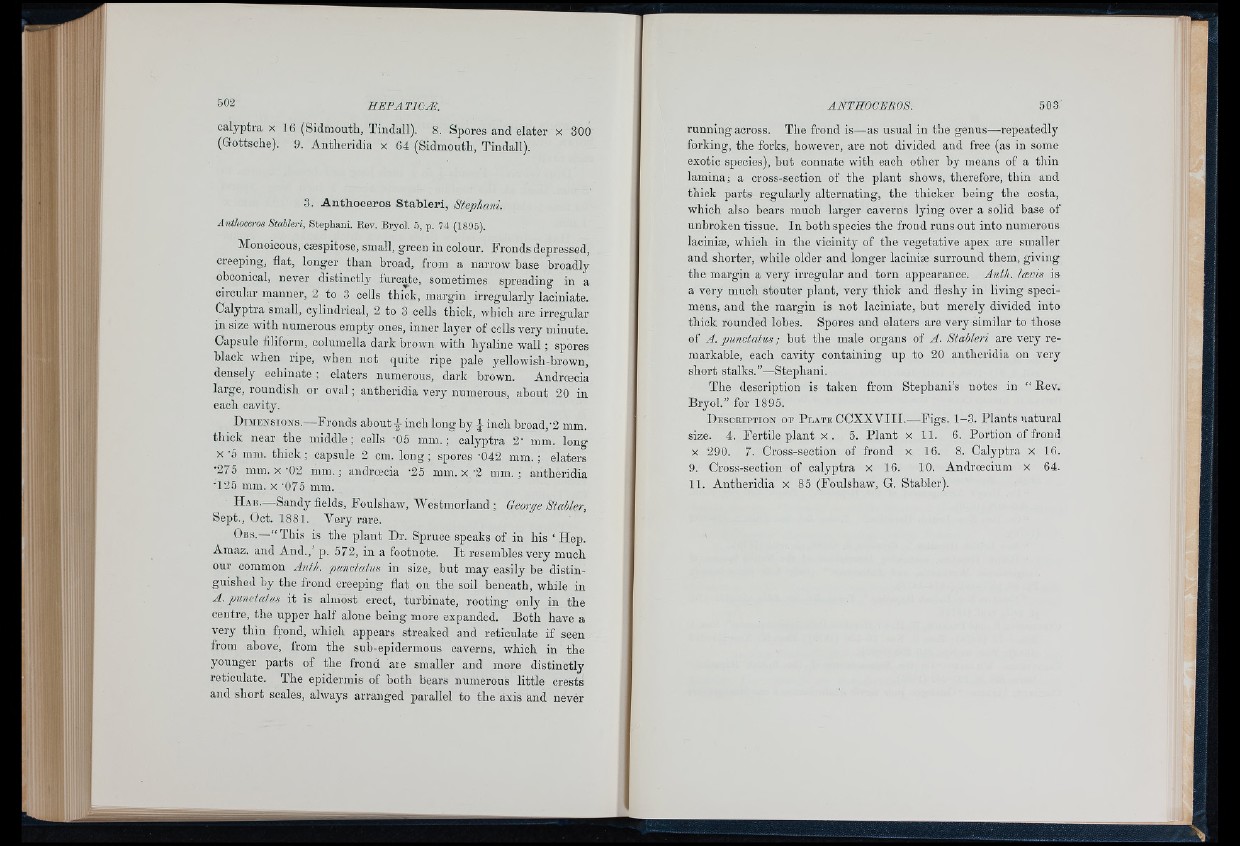
Iii' ill
I i!l
calyptra x 16 (Sidmouth, Tindall). 8. Spores and elater x 300
(Gottsche). 9. Antheridia x 64 (Sidmouth, Tindall).
3. Anthoceros Stableri, Stephani.
Anttioceros Stableri, Stephani. Eev. Bryol. 5, p. 74 (1895).
Monoicous, cæspitose, small, green in colour. Fronds depressed,
creeping, flat, longer than broad, from a narrow base broadly
obconical, never distinctly' furcate, sometimes spreading in a
circular manner, 2 to 3 cells thick, margin irregularly laciniate.
Calyptra small, cylindrical, 2 to 3 cells thick, which are irregular
in size with numerous empty ones, inner layer of cells very minute.
Capsule tiliforin, columella dark brown with hyaline wall ; spores
black when ripe, when net quite ripe pale yellowish-brown,
densely echinate ; elaters numerous, dark brown. Androecia
large, roundish or oval ; antheridia very numerous, about 20 in
each cavity.
Dimensions.—Fronds about J inch long by J inch broad,'2 mm.
thick near the middle; cells '05 mm.; calyptra 2' mm. long
X A mm. thick ; capsule 2 cm. long ; spores '042 mm. ; elaters
•275 mm. X-02 mm.; androecia -25 mm. x -2 mm.; antheridia
•1-25 mm. x -075 mm.
Hah.—Sandy fields, Foulshaw, Westmorland ; George Stahler,
Sept., Oct. 1881. Very rare.
O bs.— “ This is the plant Dr. Spruce speaks of in his ‘Hep.
Amaz. and And., p. 572, in a footnote. I t resembles very much
our common Anlh. punctatus in size, but may easily be distinguished
by the frond creeping flat on the soil beneath, while in
A. puncfahis it is almost erect, turbinate, rooting only in the
centre, the upper half alone being more expanded. Both have a
very thin frond, which appears streaked and reticulate if seen
from above, from the sub-epiderinous caverns, which in the
younger parts of the frond are smaller and more distinctly
reticulate. The epidermis of both bears numerous little crests
and short scales, always arranged parallel to the axis and never
running across. The frond is—as usual in the genus—repeatedly
forking, the forks, however, are not divided and free (as in some
exotic species), but connate with each other by means of a thin
lamina; a oross-section of the plant shows, therefore, thin and
thick parts regularly alternating, the thicker being the costa,
which also bears much larger caverns lying over a solid base of
unbroken tissue. In both species the frond runs out into numerous
laciniæ, which in the vicinity of the vegetative apex are smaller
and shorter, while older and longer laciniæ surround them, giving
the margin a very irregular and torn appearance. Anth. lavis is
a very much stouter plant, very thick and fleshy in living specimens,
and the margin is not laciniate, but merely divided into
thick rounded lobes. Spores and elaters are very similar to those
of A. pumctatus ; but the male organs of A. Stableri are very remarkable,
each cavity containing up to 20 antheridia on very
short stalks.”—Stephani.
The description is taken from Stephani’s notes in “ Rev.
Bryol.” for 1895.
Description op P late CCXXVIII.-
size. 4. Fertile plant x . 5. Plant x
x 290. 7. Cross-seotion of frond x
9. Cross-section of calyptra x 16.
-Pigs. 1-3. Plants natural
11. 6. Portion of frond
16. 8. Calyptra x 16.
10. Androeoium x 64.
11. Antheridia x 85 (Foulshaw, G. Stabler).